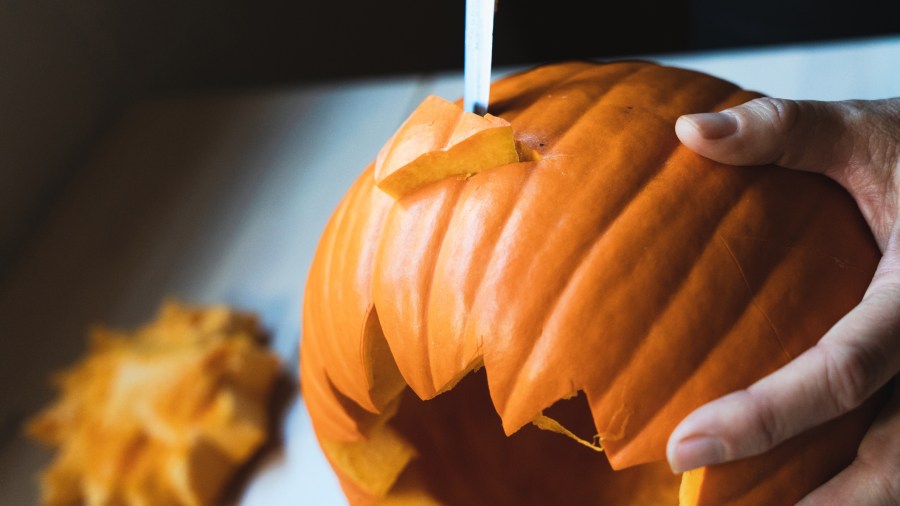(NEXSTAR) – You don’t know jack about carving a pumpkin.
With autumn officially upon us and the spooky season in full swing, it’s about that time to start setting your jack-o’-lanterns on the front porch. But before you pick out a pumpkin and start hacking away, it might be wise to learn a few tips from an expert on taking your technique to the next level.
Marc Evan is one of the country’s premiere pumpkin carvers, having co-founded Maniac Pumpkin Carvers with friend and fellow artist Chris Soria nearly 15 years ago. Since that time, Evan and Soria — and their team of artists — have been commissioned to create gourd-based works of art for high-profile clients including Disney, Marvel and the MLB, for use in ad campaigns, TV shows and promotional events.
They are, as Evan says, “the pumpkin people.”
“Between August and Thanksgiving, we do nothing but pumpkinwork,” Evan tells Nexstar. “We’ve become one of the go-to sources for high-end carvings.”
The artists at Maniac Pumpkin Carving also host seasonal workshops and corporate classes, offering up tips on tools, sculpting, carving and printmaking.
Looking to try your hand at a more advanced carving technique? It’ll take some practice, of course, but Evans is ready to lend a bit of his expertise. And suggests you remember three very important things.
#1. You shouldn’t pick just any pumpkin
No matter what type of carving you’re planning, you’ll want to start with a healthy pumpkin. Otherwise, you risk having a rotten jack-o’-lantern by Halloween night.
“Pumpkins with intact stems are a good indicator of a fresher pumpkin,” Evan says. “If it’s greener, it’s really fresh. If it’s browner, or really dried out, it’s an older pumpkin.”
A good carving pumpkin should also be free of soft spots or bruising, which will lead to faster decay.
Larger pumpkins also have thicker skin, Evan finds, meaning they’re better for etching or carving into the flesh at different depths, without actually penetrating through to the center.
“And don’t pick up the pumpkin by the stem,” Evan adds. “It’s not meant to hold the weight of the pumpkin and it can crack off pretty easily … With the stem still on, [the pumpkin] is still drawing moisture, nutrients. We find they last longer.”
#2. You need to go in with a plan
“Don’t just try to figure it out with a knife in your hand,” Evan warns. “Even if you’re doing a classic jack-o’-lantern, you want to draw out the shapes you’re going to make ahead of time.”
You could always opt for a stencil, Evan says, though he rarely uses them outside of his novice classes. “We draw out the design, on paper or digitally, and then we draw it out on the pumpkin.”
Even if you’re only planning on cutting out eyes, a mouth and a nose, “you should make a sketch,” according to Evan. Otherwise, you may end up with a lopsided, off-center design.
This step is doubly important with more intricate designs. After all, not everyone wants a traditional jack-o’-lantern this Halloween.
“You can find inspiration [for elaborate ideas] anywhere… Thinking creatively is part of the fun,” Evan says. “But don’t do anything without mocking it up on paper first.”
#3. You don’t need to use ‘pumpkin-carving’ tools
Those carving kits you see at the drug store? There’s nothing really wrong with them, although they might be limiting your potential.
“We use very few tools that were designed for pumpkins,” Evan says of Maniac’s designs. “Some of my favorite tools are actually found in the kitchen or the toolbox.”
For instance, Evan suggests grabbing “a melon baller, or a lemon zester, or even various drill bits” for texture and detail. The artists at Maniac also often use wood-carving tools, like gouges, for precision and depth when creating the “etching”-type designs, or lithophanes, that Maniac has come to be known for.
“It’s definitely a more advanced style, we don’t frequently teach it… but it gives us more photorealism, more photorealistic portraits.”
To really make the designs shine, the artists at Maniac rarely use candles to illuminate their carvings, opting instead for bright LED bulbs.
“Candles are just not bright enough to get the effects we’re trying to achieve,” Evan says.
If used in a safe environment, a candle is perfectly adequate for smaller jack-o’lanterns, with cuts that go deep enough to reach through the flesh. A small battery-operated bulb works too, and helps avoid “cooking” the insides of the gourd, Evan says.
Evan stresses, though, that there’s no wrong way to carve a jack-o’-lantern, as long as it’s done safely, and in good spirits.
“We love pumpkins and we love Halloween,” Evan says. “If there’s one thing we don’t like about pumpkins, it’s pumpkin-spice lattes, or pumpkin lattes. We love seeing the inspirations and all that stuff, but the artificial pumpkin flavors? That’s what we’re a little tired of.”
